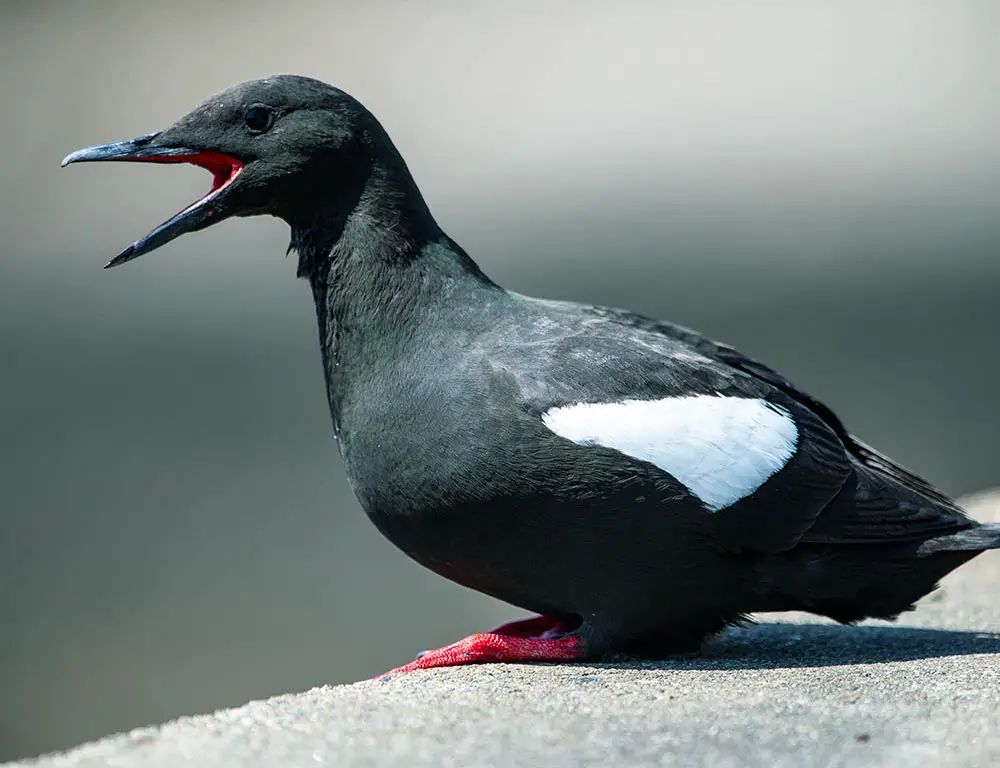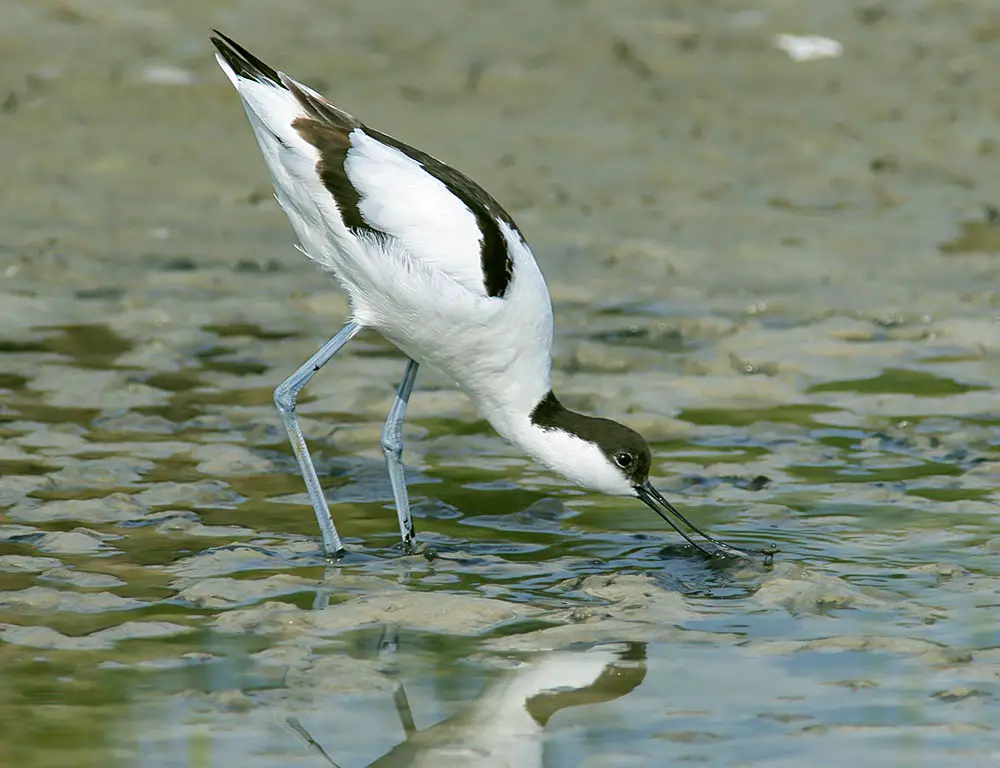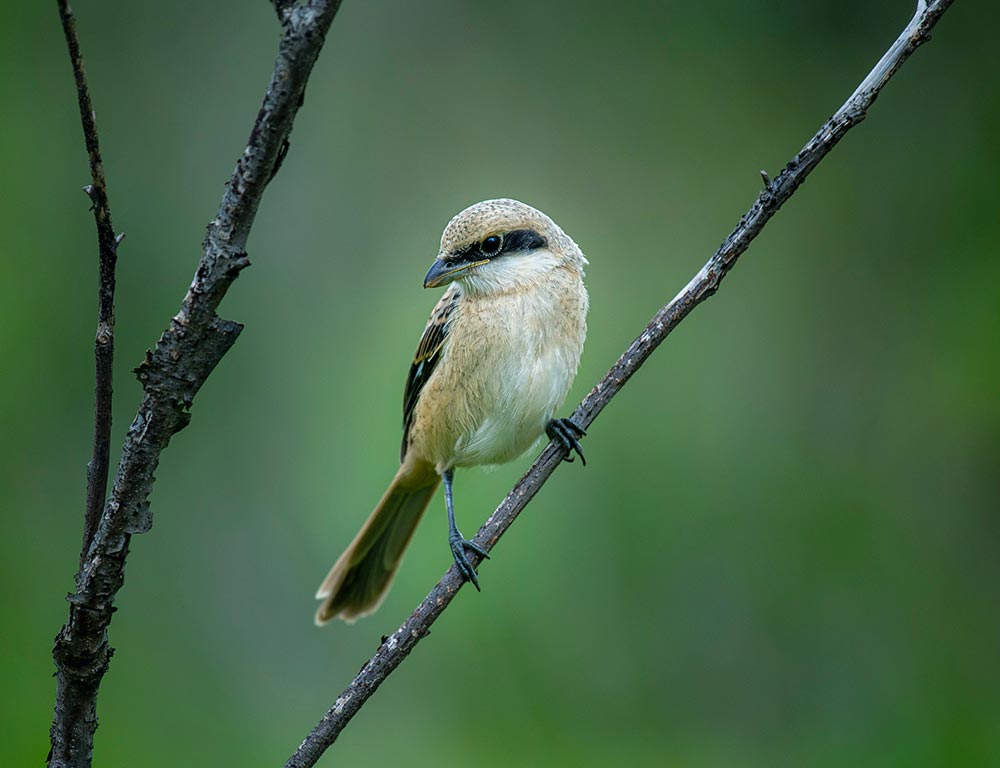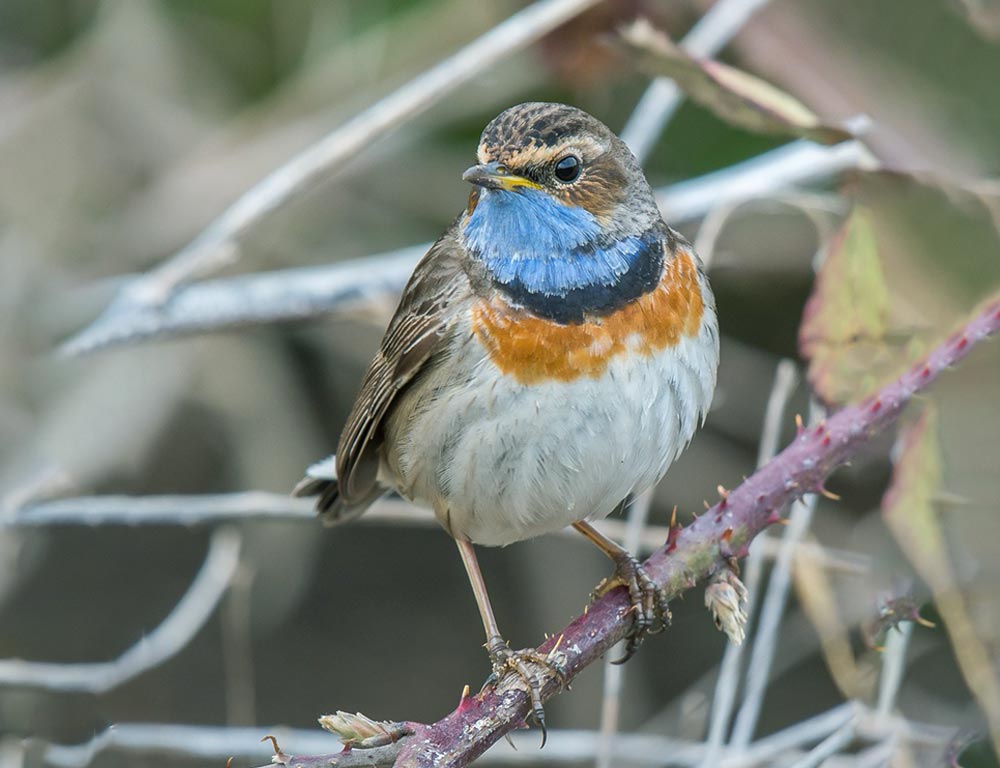In the diverse avian tapestry of the United Kingdom, numerous black and white feathered inhabitants contribute to the country’s rich biodiversity.
From coastal cliffs to woodlands, these contrasting-colored birds adorn the skies and landscapes, captivating birdwatchers and enthusiasts alike.
Remarkably varied in size, behavior, and habitats, these monochromatic avians bring a sense of elegance and intrigue to the natural tapestry of the UK. This compilation encompasses an array of species, each with its unique characteristics and adaptations.
Some, like the charismatic Great Spotted Woodpecker, punctuate woodlands with their distinctive drumming, while others, such as the agile Razorbill, navigate coastal waters with grace.
From the social gatherings of Long-tailed Tits to the solitary majesty of the Great Black-backed Gull, these black and white birds exemplify the resilience and adaptability required to thrive in the UK’s diverse ecosystems.
20 Black and White Birds in the UK
Let’s explore the fascinating world of 20 black and white birds, as we unravel the tales of their lifestyles, contributions to ecosystems, and the conservation efforts aimed at ensuring their continued presence in the British Isles.
1. Great Spotted Woodpecker

- Scientific name: Dendrocopos major
- Category: Bird
- Life span: 4-7 years
- Population: Stable
- Size: 23–26 cm
- Weight: 70–100 g
- Status: Least Concern
The Great Spotted Woodpecker, characterized by distinctive black and white plumage, is a skilled drummer, often heard before.
Common in woodlands, parks, and gardens, it feeds on insects, larvae, and seeds. Their drumming and distinctive calls contribute to the forest’s rhythmic sounds.
With a lifespan of 4-7 years, these birds contribute to a stable population, and their ability to adapt to various habitats aids their status as “Least Concern.”
2. Long-tailed Tit

- Scientific name: Aegithalos caudatus
- Category: Bird
- Life span: 2.7 years
- Population: Increasing
- Size: 13 cm
- Weight: 7-9 g
- Status: Least Concern
Long-tailed Tits, small, fluffy birds, are social and often move in mixed flocks. With a lifespan of around 2.7 years, these birds have a gradually increasing population.
Their intricate nests, constructed from moss and spider silk, are a marvel. Active insect feeders bring charm to gardens, woodlands, and hedgerows. Despite their small size, they thrive, earning a “Least Concern” status.
3. Gannets

- Scientific name: Morus bassanus
- Category: Seabird
- Life span: 20 years
- Population: Stable
- Size: 87-100 cm
- Weight: 2.2-3.6 kg
- Status: Least Concern
Gannets, large seabirds with striking white plumage and black wingtips, are exceptional divers. Living up to 20 years, they form massive colonies on cliffs and islands. Feeding on fish, they plunge into the sea from impressive heights.
Their stable population and adaptability contribute to their “Least Concern” status, showcasing their resilience in coastal habitats.
4. Black Guillemot

- Scientific name: Cepphus grylle
- Category: Seabird
- Life span: 20 years
- Population: Stable
- Size: 32-38 cm
- Weight: 500-700 g
- Status: Least Concern
The Black Guillemot, with distinctive black plumage and white wing patches, inhabits coastal areas. These seabirds, with a lifespan of 20 years, nest in crevices and feed on fish.
Their stable population, resilient to habitat changes, secures their “Least Concern” status. Their agile underwater movements and characteristic calls make them a fascinating part of the coastal ecosystem.
5. Razorbill

- Scientific name: Alca torda
- Category: Seabird
- Life span: 13 years
- Population: Stable
- Size: 38-43 cm
- Weight: 0.75-1 kg
- Status: Least Concern
Razorbills, black and white seabirds, are skilled divers. Preferring coastal cliffs for breeding, they lay a single egg. With a lifespan of 13 years, they form colonies during the breeding season.
Their diet consists mainly of fish, and their stable population earns them a “Least Concern” status. Their streamlined bodies and strong wings enable them to navigate the coastal waters with ease.
6. Pied Avocet

- Scientific name: Recurvirostra avosetta
- Category: Wader
- Life span: 9 years
- Population: Increasing
- Size: 42-45 cm
- Weight: 290-380 g
- Status: Least Concern
Pied Avocets, known for their upturned bills, thrive in shallow waters. With a lifespan of 9 years, these elegant waders have a gradually increasing population.
Their distinct feeding method, sweeping their bills through water to catch small invertebrates, adds to their charm.
Their adaptability to varied wetland habitats contributes to their “Least Concern” status, making them a delightful sight for birdwatchers.
7. Tufted Duck

- Scientific name: Aythya fuligula
- Category: Waterfowl
- Life span: 10 years
- Population: Stable
- Size: 40-47 cm
- Weight: 750-1200 g
- Status: Least Concern
Tufted Ducks, with striking tufts on their heads, are common in freshwater habitats. With a lifespan of 10 years, they feed on aquatic plants and invertebrates.
Their stable population, adaptable nature, and distinctive plumage contribute to their “Least Concern” status. These diving ducks are known for their agile swimming and courtship displays during the breeding season.
8. Common Eider

- Scientific name: Somateria mollissima
- Category: Sea Duck
- Life span: 20 years
- Population: Decreasing
- Size: 50-71 cm
- Weight: 0.95-3.2 kg
- Status: Near Threatened
Common Eiders, with their large size and distinctive plumage, inhabit coastal areas.
With a lifespan of 20 years, their population is unfortunately decreasing, leading to a “Near Threatened” status. They primarily feed on mollusks and crustaceans.
Factors like habitat degradation and hunting contribute to their decline. Conservation efforts are crucial to ensuring the survival of these sea ducks and preserving the balance of coastal ecosystems.
9. Great Black-backed Gull

- Scientific name: Larus marinus
- Category: Seabird
- Life span: 15 years
- Population: Stable
- Size: 64-79 cm
- Weight: 1.5-2.3 kg
- Status: Least Concern
Great Black-backed Gulls, with bold black backs and wings, are formidable predators. They inhabit coastal areas and islands.
With a lifespan of 15 years, these gulls are opportunistic feeders, preying on fish, birds, and even smaller gulls. Their large size and dominance contribute to their “Least Concern” status, as they adapt well to various marine environments.
10. White Wagtail

- Scientific name: Motacilla alba
- Category: Bird
- Life span: 3 years
- Population: Stable
- Size: 16-20 cm
- Weight: 15-25 g
- Status: Least Concern
White Wagtails, with their distinct black and white plumage, are commonly found near water bodies. With a lifespan of 3 years, they feed on insects and often wag their tails.
Their stable population and adaptability to diverse habitats, including urban areas, earn them a “Least Concern” status. These active birds are known for their agility in catching flying insects.
11. Tit (Great Tit, Blue Tit, etc.)

- Scientific name: Paridae family (e.g., Parus major – Great Tit)
- Category: Bird
- Life span: 2 years
- Population: Stable
- Size: Varies (e.g., 12 cm for Great Tit)
- Weight: Varies (e.g., 18 g for Great Tit)
- Status: Least Concern
Various tit species, including Great Tits and Blue Tits, are small, lively birds found in diverse habitats. With a lifespan of around 2 years, these birds are insectivores, contributing to pest control.
Their stable populations and adaptability to nesting in various locations, such as tree holes and nest boxes, contribute to their “Least Concern” status.
Their colorful plumage and energetic behavior make them popular among bird enthusiasts.
12. American Goldfinch

- Scientific name: Spinus tristis
- Category: Songbird
- Life span: 6-7 years
- Population: Stable
- Size: 11-13 cm
- Weight: 11-20 g
- Status: Least Concern
American Goldfinches, with vibrant yellow plumage, are songbirds common in North America. With a lifespan of 6-7 years, they are granivores, feeding on seeds, especially from thistles.
Their stable population and adaptability to various habitats contribute to their “Least Concern” status. These acrobatic birds are known for their musical calls and lively presence, adding color to gardens and open areas.
13. Rook

- Scientific name: Corvus frugilegus
- Category: Bird
- Life span: 15 years
- Population: Stable
- Size: 45–47 cm
- Weight: 400–600 g
- Status: Least Concern
The Rook, a member of the crow family, is a highly intelligent and social bird. With a lifespan of up to 15 years, they have a stable population.
Recognizable by their black plumage and distinctive bare grey face, Rooks are often found in large, noisy colonies called rookeries.
These birds are omnivores, feeding on a varied diet including insects, small mammals, seeds, and carrion. They are known for their remarkable problem-solving skills and ability to use tools.
Rooks play a vital role in ecosystems by helping control insect populations and contributing to seed dispersal. While their population is currently stable, changes in agriculture practices and habitat loss can impact their nesting and foraging opportunities.
14. Little Egret

- Scientific name: Egretta garzetta
- Category: Wader
- Life span: 5-10 years
- Population: Increasing
- Size: 55-65 cm
- Weight: 350-550 g
- Status: Least Concern
Little Egrets, with their elegant white plumage, are wading birds commonly found near water bodies. With a lifespan of 5-10 years, their populations are increasing.
They feed on fish, insects, and amphibians, using their slender bills to snatch prey. Their adaptability to various wetland habitats and their increasing numbers contribute to their “Least Concern” status.
15. Black Grouse

- Scientific name: Lyrurus tetrix
- Category: Gamebird
- Life span: 2-4 years
- Population: Decreasing
- Size: 50-55 cm
- Weight: 1,000-1,450 g
- Status: Near Threatened
Black Grouse, known for the males’ striking black plumage and white tail feathers, inhabit moorlands and forest edges.
With a lifespan of 2-4 years, their populations are decreasing. Males perform elaborate displays during the breeding season.
Habitat loss and disturbance contribute to their decline, leading to a “Near Threatened” status. Conservation efforts aim to protect their habitats and reverse the population trend.
16. Bufflehead

- Scientific name: Bucephala albeola
- Category: Waterfowl
- Life span: 4-5 years
- Population: Stable
- Size: 32-40 cm
- Weight: 270-635 g
- Status: Least Concern
Buffleheads, small diving ducks with striking black and white plumage, are found in North America. With a lifespan of 4-5 years, they feed on aquatic invertebrates.
Their stable population and adaptability to various water bodies contribute to their “Least Concern” status.
Known for their agile diving and courtship displays, Buffleheads add vibrancy to freshwater habitats. Conservation efforts focus on preserving their nesting sites and ensuring water quality.
17. Gyrfalcon

- Scientific name: Falco rusticolus
- Category: Bird of prey
- Life span: 13 years
- Population: Stable
- Size: 48-61 cm
- Weight: 800-1300 g
- Status: Least Concern
Gyrfalcons are powerful raptors inhabiting the Arctic and subarctic regions. With a lifespan of 13 years, they exhibit a stable population.
Known for their adaptability to harsh environments, these falcons hunt various prey, including birds and mammals. Their swift flight and keen eyesight make them formidable hunters.
While not globally threatened, climate change affecting their Arctic habitats raises concerns. Conservation efforts target the preservation of their breeding grounds and the mitigation of environmental changes.
18. Shrike

- Scientific name: Laniidae family (e.g., Great Grey Shrike – Lanius excubitor)
- Category: Bird
- Life span: 4 years
- Population: Stable
- Size: Varies
- Weight: Varies
- Status: Least Concern
Shrikes, including the Great Grey Shrike, are passerine birds known for their predatory behavior.
With a lifespan of around 4 years, they have a stable population. Shrikes feed on insects, small birds, and rodents, often impaling their prey on thorns.
Their adaptability to diverse habitats contributes to their “Least Concern” status. Conservation efforts focus on maintaining suitable habitats for these efficient predators.
19. Mistle Thrush

- Scientific name: Turdus viscivorus
- Category: Songbird
- Life span: 6 years
- Population: Stable
- Size: 28-33 cm
- Weight: 110-140 g
- Status: Least Concern
Mistle Thrushes, with a distinctive appearance, are songbirds found in woodlands and gardens. With a lifespan of 6 years, they have a stable population. They feed on insects, berries, and earthworms.
Known for their melodious songs and bold behavior, Mistle Thrushes contribute to the avian diversity in various habitats. Their adaptability and widespread distribution contribute to their “Least Concern” status.
20. Bluethroat

- Scientific name: Luscinia svecica
- Category: Songbird
- Life span: 2 years
- Population: Stable
- Size: 13-14 cm
- Weight: 12-20 g
- Status: Least Concern
Bluethroats, named for the vibrant blue and orange markings on the male’s throat, are migratory songbirds. With a lifespan of 2 years, they have a stable population. Found in marshy areas, they feed on insects and small invertebrates.
Their captivating song and colorful plumage make them sought after by birdwatchers. Conservation efforts focus on preserving their breeding and stopover sites during migration.
Wrapping Up
In concluding our exploration of the enchanting black and white birds of the UK, we unveil a mosaic of diverse avian tales.
From the rhythmic drumming of woodpeckers to the coastal acrobatics of gulls, these feathered inhabitants exemplify the resilience and adaptability crucial for their survival in varying ecosystems.
Amidst woodlands, cliffs, and wetlands, their contrasting plumage paints vivid strokes on the canvas of British nature. These avians, both iconic and discreet, play pivotal roles in maintaining ecological balance.
The conservation efforts underway to protect their habitats and ensure their thriving presence underscore the significance of preserving the intricate tapestry of biodiversity.
Embark on a journey through the avian wonders of the UK, where black and white feathers tell stories of survival, adaptation, and the delicate harmony of nature.